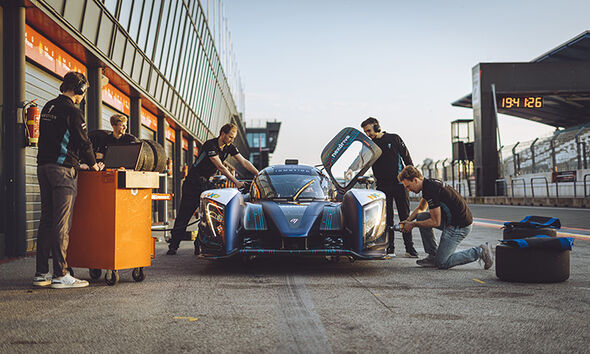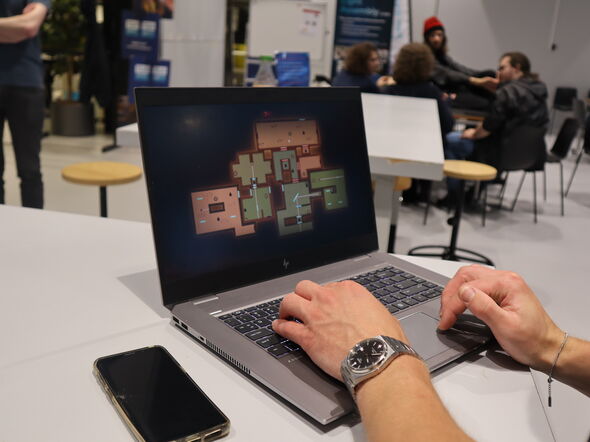
The ultimate group project: student teams
Working with students from different departments on one big project
TU/e has dozens of student teams working on the most diverse topics. For example, Team IGNITE creates light art, InMotion works on fast charging times for electric racing cars, students from Totem Game Dev develop their own video games and Team POLAR creates an autonomous vehicle to explore Antarctica.
TEAM IGNITE | Unite with light
Combining art with technology to unite one another, that’s what makes student team IGNITE unique, according to PR cluster member Vera Scheve (21). The art form in question: light, preferably interactive.
For several years, Team IGNITE has built interactive light installations for the world-renowned light art festival GLOW, which takes place in Eindhoven every year. Scheve: "Last year we participated with our project ‘GLOWBLE’, a gigantic ball of light that reacted to sound, if visitors clapped or screamed, for example. We won the GLOW audience award with that."
This year Team IGNITE is again working on a new GLOW project, but in addition the team has ambitions beyond the festival. For example, this year they hope to participate in their very first international light art festival and they are working on a light installation for one of the new student towers on campus. Scheve: "It will be an installation that mimics the sun, to give the mostly international students living in these residential towers a warm feeling in rainy Holland."
This all sounds very ambitious, but according to Scheve, you can make it as busy as you want at Team IGNITE. "Some people do a full time board year and others only work one working day a week. It depends on how much time you have and what you want to learn. Then we see how we can adapt the team to the student, not the other way around.” (CdW)
InMotion| Fast, faster and even faster charging
The big dream of student team InMotion is to compete in the 24 Hours of Le Mans race with an electric race car. In order to reach that goal, the team is working on a battery pack that must be able to charge very quickly as well as maintain high speeds for a very long time. Last summer, InMotion already demonstrated that it is possible to achieve a charging time of 4 minutes.
During the past year, the students have mainly been working on ensuring that the battery pack remains intact when ragging the race car along the track at 300 km/hr. This comes with a number of challenges, explains team manager Wouter Brans (22). “For example, we’re working on vibration problems. When you drive over a curb on the track, the battery pack must be able to withstand the impact. Everything must be absolutely rock solid, none of the 800 cooling connections can come loose and nothing can leak.”
Another challenge is dealing with setbacks, he says. “We worked a 90-hour week once. During the test on Sunday night, it turned out that the insulation value was too high, and we had to start all over again.” Fortunately, the team spirit helps put those kinds of setbacks into perspective, says Coen Hiddink (23). “We keep the mood up by doing fun things together outside of work. That also makes it feel less like work.”
Most members are full-timers and dedicate themselves to InMotion for a whole year. Brans: “You have to plan your private life differently. That’s why it’s good to do it for just a year. So you can give it your all.” And that is well worth it, Hiddink agrees. “You have struck gold. Everyone wants to see that.” That’s what you do it for. And for accelerating the energy transition, of course: “That’s an additional goal. To show people all the possibilities in electric driving. We’ve already come a long way.” (LA)
Totem Game Dev | For anyone who wants to make games
Each year, over thirty members of Totem Game Dev work on multiple games. Anyone who joins automatically becomes a member of an international community of five hundred game developers through the team's open Discord server.
Egor Larionov (22) explains: “We take on four to five smaller projects every year to learn the basics, even if you have no prior experience. We provide computers for students if they don't have the hardware themselves.” In small teams, students learn all aspects of game development, from programming to designing characters, movements, and visuals. “At the end of the year, we have an award ceremony for the best project.”
In addition, the team organizes a larger project annually for students who have already mastered the basics. Last year, they created the game “Observe”, which will soon be available for purchase on Steam. Maarten Hundscheid (22): “The game has a unique mechanic where you have to solve puzzles to escape a dungeon, but your actions in each room affect the next room.”
This academic year, the team is adding another project. The “Gamification Squad”, led by Hundscheid, is creating a game in order to solve a social issue. “We are in contact with the municipality of Eindhoven, among others, to identify a problem we could address through this game.”
In addition to developing games, they also present them, for example at events such as the Night of the Nerds. Moreover, the team organizes lectures on the profession and visits to game studios. Larionov: “We organize activities to train soft skills so people can grow socially and professionally, as well as master the technical aspects.” And of course, there's always time for a game of Mario Kart or FIFA.
If you join the team, you don’t have to worry about it affecting your studies. “You can decide for yourself when and how much you work,” says Larionov. “Above all, we want to create a safe environment where everyone works in a way that suits them.” (WK)
Team polar | Research in the world's coldest place
Enabling autonomous research in Antarctica. That's the goal of Team POLAR. Team manager Ignacio Becerra Osorio (21): "This means using robotics and AI to enable research in one of the harshest environments on earth." According to Becerra Osorio, there are just a few focussing on this area. "Research has been done in Antarctica using aquatic and aerial means like drones or boats, but we're one of the very few to do it on land."
This is because the land in Antarctica is an incredibly valuable research area (for meteorite research, for example), but at the same time also very dangerous because of the extreme weather conditions. For this reason, the student team built the "Ice Cube". An autonomous research vehicle that can drive itself and can withstand extremely low temperatures as low as -40 degrees Celsius.
Last year, Team POLAR developed their first prototype of the Ice Cube after which they tested it in the coldest and northernmost point of Norway. However, the final destination for the Ice Cube is, of course, Antarctica. Becerra Osorio: "If everything goes well, our plan is to go there December 2026." Possibly not only with the Ice Cube, but also with a larger model that the team will begin working on this year.
According to Becerra Osorio, students join Team POLAR for a variety of reasons. "Some want to contribute to sustainable research opportunities, others are excited they’re working on a brand new concept and what attracted me personally was the challenge of developing something that has to withstand extreme temperatures." In addition, Team POLAR is one of the most international teams, which is also a plus for many, Becerra Osorio says.
As for the workload, you get to choose how much time you’d like to spend with both part time and full time being possible. However, for part timers, the team recommends an average of 10-15 hours per week. “But, more is always possible, of course.” (CdW)





Discussion